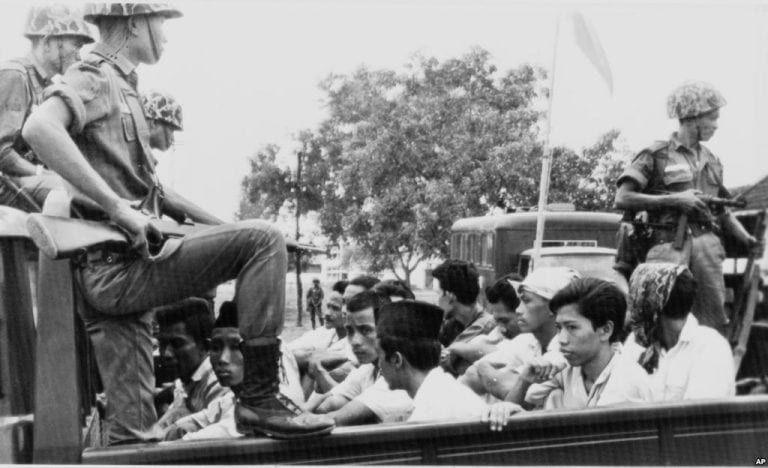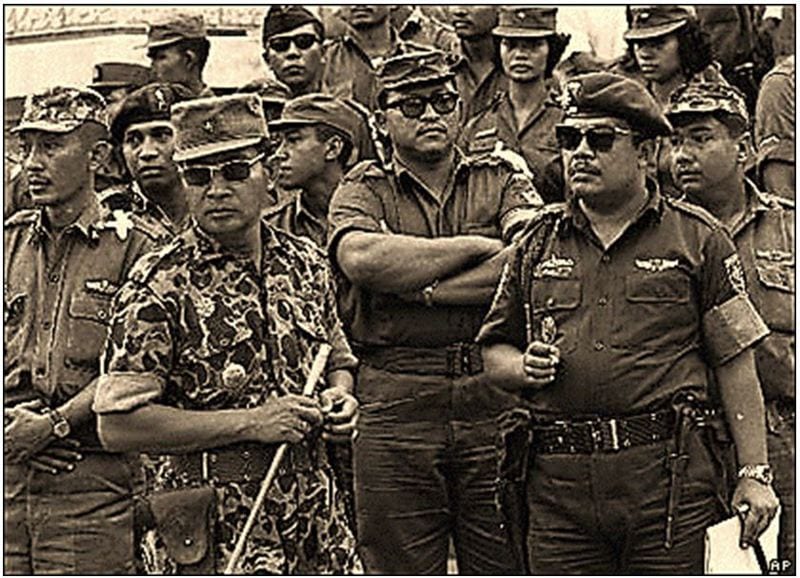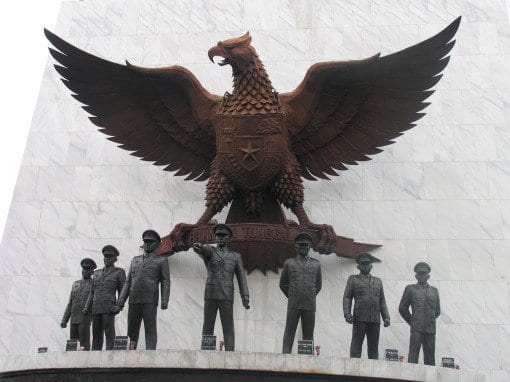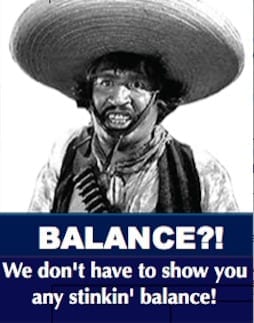The Indonesian Massacre: What Did the US Know?
![]()
//
By Margaret Scott
The New York Review of Books
 One of the most sordid and heinous crimes of the Us government in the 20th century is receiving some attention, even in unexpected quarters, like the NYR of Books. High time the mainstream media paid even a modicum of attention to this monumental tragedy. We therefore welcome the publication of this article on NYR.
One of the most sordid and heinous crimes of the Us government in the 20th century is receiving some attention, even in unexpected quarters, like the NYR of Books. High time the mainstream media paid even a modicum of attention to this monumental tragedy. We therefore welcome the publication of this article on NYR.
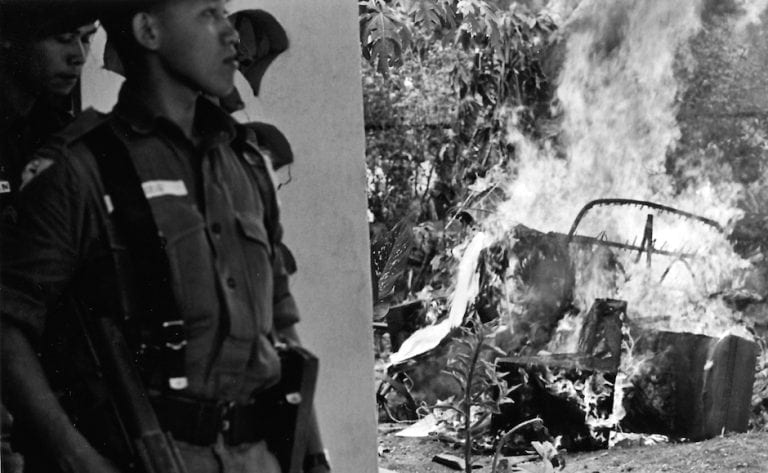
Indonesian soldiers near the burning wreckage of a vehicle, following the assassination of six army generals, Jakarta, October 1965
President Barack Obama has several things in common with Joko Widodo, the president of Indonesia, whom he welcomed to the Oval Office last week. The two men are the exact same age, and Widodo, whom everyone calls Jokowi, looks like a shorter and skinnier version of Obama. They also share something else: a personal connection to one of the worst massacres anywhere since World War II. In the late 1960s, Obama lived in Jakarta with his mother, in the years just after the killings of hundreds of thousands of suspected Indonesian Communists, a carefully orchestrated purge that brought the US-backed New Order regime to power; Jokowi grew up in poverty in Central Java, near a river that was filled with corpses in 1965.
As it happens, a cache of intelligence documents declassified by the CIA this fall offers a new opportunity to revisit those events, and the US’s involvement in them. Moreover, Jokowi took office last year as the first president from outside the tight circle of oligarchs and political elite that flourished for decades under the New Order and even after its collapse in 1998. He promised to bring open, pluralist rule to Indonesia’s 250 million people, who are spread across 17,000 islands and who make up the world’s largest Muslim-majority nation. Many hoped Jokowi’s reforms would include a full reckoning with the fifty-year-old killings. The question is whether Obama is prepared to support Jokowi, whose troubled administration faces stiff resistance to addressing what happened in 1965.
The Indonesian massacre was a critical moment in the cold war. In the early morning of October 1,1965, six Indonesian generals were killed by a group of junior officers who claimed they were forestalling a takeover by a CIA-backed “Council of Generals.” The putsch was poorly planned and collapsed in twenty-four hours. At the time, Indonesia was led by the leftist, romantic revolutionary-turned-autocrat Sukarno, and also had the third largest Communist Party in the world, the PKI, with some 3 million members. The Indonesian Army and the US government quickly blamed the botched coup on the PKI. (There is still much we don’t know about these events, but the head of the PKI, D. N. Aidit, was at least aware of the coup attempt; he was killed shortly thereafter by the army.) Seizing on an opportunity to unseat Sukarno and roll back communism, the army unleashed a campaign of violence in which perhaps five hundred thousand or perhaps one million suspected Communists were killed—no one knows for sure.
The assassination of the six generals, and fabricated stories that they had been tortured by Communist women, were used to stir up anti-Communist sentiment. Within days, the army and army-affiliated militias spread out across the archipelago, arresting anyone who was associated with the PKI and its many labor and farmer organizations. Then, mostly at night, those arrested were taken out and shot, beheaded, or stabbed to death. The army’s militias did most of the killings, and their members ranged from gangsters to young men who belonged to the country’s two largest Muslim organizations. The victims were thrown in mass graves or into rivers, and there are harrowing stories of rivers in Java, Sumatra, and Bali so filled with bodies that the water turned red.
For the Lyndon Johnson administration, the bloodbath was a momentous victory, shifting the balance of power in Southeast Asia. But for many Indonesians it was a terrifying time. In addition to those murdered, hundreds of thousands more were imprisoned, and their families and the families of the victims were formally shunned. When the killings ended, Indonesians lived under the military rule of General Suharto, who promoted the founding myth that the army saved the nation from the atheist Communists. No one talked about what had happened.
In 1967, a six-year-old Obama moved with his mother, Ann Dunham, to Jakarta as Suharto consolidated his jackboot rule. “Innuendo, half-whispered asides; that’s how she found out that we had arrived in Djakarta less than a year after one of the more brutal and swift campaigns of suppression in modern times,” Obama writes in his memoir, Dreams from My Father. “The idea frightened her, the notion that history could be swallowed up so completely.”

Indonesian President Joko Widodo and US President Barack Obama at the White House, Washington, DC, October 26, 2015
[dropcap]S[/dropcap]ince the late 1990s, however, there have been growing efforts to recover that history. In 1998, Indonesians rose up against Suharto, whose military dictatorship had lasted thirty-two years. This movement, known as reformasi, and Suharto’s fall, brought new scrutiny to the events of 1965. Many Indonesians rebelled against the taboo of talking about the mass killings, which they began investigating through journalism, books, and films. In recent years, local organizations have also sought to locate the mass graves and assist the survivors. These efforts have been aided by US records. In 2001, despite the efforts of the CIA to prevent it, the US released Foreign Relations of the United States, 1964-1968, a State Department volume that included long-secret government documents from that period. It describes how US officials pushed for the annihilation of the PKI, providing covert assistance and urging the Indonesian army to complete the job.
//
But the documents did not reveal when the plan for mass killings was devised, and when the US knew about it. Some of these questions have now come more sharply into focus with the release on September 16 of more CIA documents, including, for the first time, records of what the CIA was telling President Johnson as the failed coup quickly became a pretext for mass murder. Prodded by a court ruling, the CIA declassified redacted versions of all of the Presidential Daily Briefs, considered the most important and most closely held intelligence information, from 1961 to 1969. These documents don’t change the underlying story we have about 1965, but they do provide the best evidence yet of how hard the US was pushing for the eradication of the Communists and the routing of the pro-Chinese Sukarno.
Despite the fact that the US was at the time escalating its involvement in Vietnam, Indonesia was the first item on the president’s daily brief almost every day from the failed coup at the beginning of October to the end of November of that year. To read these briefs is to be immersed in the Johnson administration’s analysis of this period as the now-or-never time “to roll up the Communists” in Indonesia, as the October 4 brief puts it. (It is the same period that Joshua Oppenheimer’s extraordinary films, The Act of Killing [2012] and The Look of Silence [2014] explore—first through the eyes of the killers and then of the victims.)
Day after day, President Johnson was updated on the Indonesian army’s move against the Communists, with little regard to the violence involved. “From all indications,” the October 6 brief states, “the army’s leadership still very much wants to have it out with the Communists and is becoming more wary of Sukarno himself.” Two days later, Johnson was told that “the generals’ staying power in a drive against the Communists remains to be established,” and then there are five lines redacted. Some of the briefs mention arrests and army sweeps at night, but there is no mention of the mass killings that continued for months.
Indonesian newspapers did not report on the atrocities. The New York Times and The Washington Post noted that there were reports of secretive, organized killings of suspected Communists, but the army confined foreign correspondents to the capital for months. By December, Indonesia was no longer number one in the briefs, but still appeared regularly, with reports on the continuing power struggle between the army and Sukarno, who still considered himself “president for life” and maintained popular support as Indonesia’s leader in the war for independence from the Dutch. Most of the briefs from December to March describe the slow but sure ascendency of the US’s strongman, General Suharto.
On March 12, 1966, Indonesia once again led the daily brief. “The army now has the situation in hand, but it is too early to assume that Sukarno is down for good. The people in Djakarta nevertheless are clearly with the military and the capital is reported quiet,” the brief explains. “It still remains to be seen whether the army will move quickly to consolidate its position. The first signs look promising; the Communist Party has finally been banned.” By this point, the killing spree was largely over.
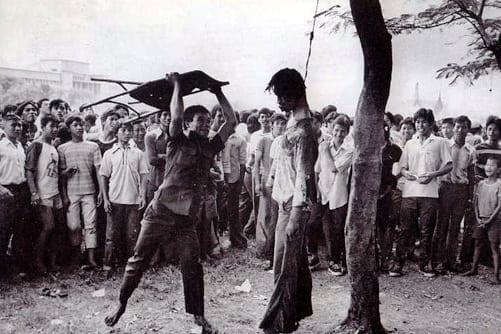
The country was engulfed in the most vicious violence, often ignited by old feuds and religious fanaticism.
Because the released documents are heavily censored, many secrets remain. Obama would do Indonesia’s fragile democracy a lot of good by helping Jokowi pry loose more of this still-hidden history, including other classified documents such as the daily reports of the CIA—which might indicate how much the generals were telling the CIA and how the US responded. This seems unlikely, since further declassification would likely require a forceful request by the Indonesian government or by a truth commission.
That’s too bad for Indonesians, who have been slowly creating a new democratic politics since 1998. Seventeen years later, Indonesia and Jokowi are caught up in a dramatic but predictable mess: a vibrant democracy struggles to exist alongside an entrenched oligarchy and a corrupt political elite. One reason is that while Suharto is long gone, much of the elite of the New Order dictatorship—the generals, the oil and coal tycoons, the political elite and powerbrokers—have thrived. The reformasi era has brought hotly contested direct elections and a boisterous free press, but it hasn’t taken away the impunity of the Indonesian army, which has never had to answer for the 1965 massacre.

A soldier guarding suspected Communists in Tangerang, a suburb of Jakarta, December 1, 1965
The struggle between reformers and holdovers of the New Order was the backdrop of Jokowi’s presidential campaign. Jokowi grew up in the 1960s in a poor neighborhood in Solo, a regional city in Central Java; in 2005 he became Solo’s immensely popular, can-do mayor. He was the face of reformasi, and his humor, his humble manner, his famous strolls through markets, and his quirky love for Heavy Metal bands made him a darling with the Indonesian press. He soared onto the national stage, becoming Jakarta’s governor in 2012, and then, in 2014, making a successful run for the presidency.
Those who elected Jokowi had sky-high expectations of a reinvigorated fight against corruption, and even an effort to take on the army for its human rights abuses. There was talk before the fiftieth anniversary of the 1965 killings this month that Jokowi would offer a formal apology to the survivors and victims’ families. But Jokowi’s first year in office has revealed the limits of his power. He does not control the parliament, and even the party that nominated him refuses to push his agenda.
China’s downturn has hurt Indonesia’s economy, and Jokowi’s government is scrambling to create jobs while nearly 40 percent of Indonesians live on $2 a day or less. A horrible haze has settled over the region because of forest fires to clear land, often so that oligarchs and well-connected military figures can build palm oil plantations; Jokowi has been unable to do anything. And through his own political missteps, Jokowi has weakened the Anti-Corruption Commission, the most effective reformasi institution. His poll numbers have plummeted, and a recent poll showed that if there were another election, Prabowo Subianto, the establishment politician he defeated last year, would beat him.
It wasn’t surprising, then, that talk of a truth commission or an apology for the killings has stopped. Already in August, leaders in parliament said they opposed it, while generals and Islamist politicians warned darkly of a revival of atheistic neo-communism. Jokowi got the message. Revisiting 1965 is politically risky; too many have acquired great wealth and power because of the New Order and they have no interest in reexamining its founding myth.
Even unofficial discussions of the massacre have provoked a backlash from the political establishment. This month Indonesia was the guest of honor at the Frankfurt Book Fair, and the three novelists receiving the most attention have each placed 1965 in the center of their fiction. The day the book fair opened, Islamist groups protested in Jakarta that these Indonesian authors were actively promoting communism. Indonesia’s own premier annual literary event, the Ubud Writers & Readers Festival, which began on October 28, was forced to cancel three sessions about 1965, including a screening of Oppenheimer’s second film and a panel with the novelist Eka Kurniawan, one of the authors featured in Frankfurt. A police official said that unless those sessions were omitted, the whole festival would be shut down. “The spirit of the festival is not to discuss things that would just open old wounds,” he said.
The new details emerging from the archives in both Indonesia and in Washington, however, may make this history harder to ignore. For example, Jess Melvin, an Australian Ph.D. student, recently discovered, in government archives in Aceh, Indonesian army documents that confirm that the killings were organized by the army as a systematic campaign. According to Melvin, these records show a military chain of command and orders that drove the killings and help explain the civilian participation in them. “The documents,” she writes, “demonstrate that the military leadership understood and implemented what they called the ‘annihilation of the PKI’ as an intentional and centralized national campaign.”
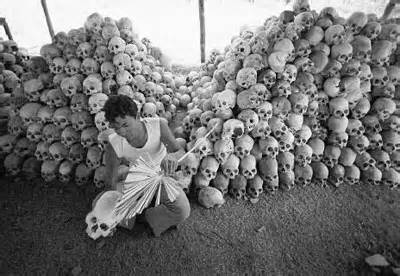
Not only was Indonesia’s anticommunist regime a murderous one, but utterly corrupt as well. Washington’s kind of ally.
The US ambassador to Indonesia at the time, Marshall Green, has insisted in interviews and in his memoir that the only US covert assistance provided to the Indonesian army was some walkie-talkies and medicine. But from the 2001 volume and from even earlier press reports, we know that the US Embassy in Jakarta also gave the army lists of PKI members—perhaps with thousands of names. And the daily briefs at least hint at greater American involvement. Until more US records are released and until the Indonesian army’s records are made public, however, the full story will not be known.
The US has done a lot to unlock the secrets of the cold war, but it can do more. Indonesia’s struggle to remain democratic, and avoid a return to strongman rule, in part depends on knowing its own history. Obama knows this, and, as president, he has the power to help fill in the historical record.
Margaret Scott is an American journalist who writes about Indonesia and is an adjunct professor at New York University’s Wagner School of Public Service. (2015)
Note to Commenters
Due to severe hacking attacks in the recent past that brought our site down for up to 11 days with considerable loss of circulation, we exercise extreme caution in the comments we publish, as the comment box has been one of the main arteries to inject malicious code. Because of that comments may not appear immediately, but rest assured that if you are a legitimate commenter your opinion will be published within 24 hours. If your comment fails to appear, and you wish to reach us directly, send us a mail at: editor@greanvillepost.com
We apologize for this inconvenience.
![]() Nauseated by the
Nauseated by the
vile corporate media?
Had enough of their lies, escapism,
omissions and relentless manipulation?
Send a donation to
The Greanville Post–or
But be sure to support YOUR media.
If you don’t, who will?
